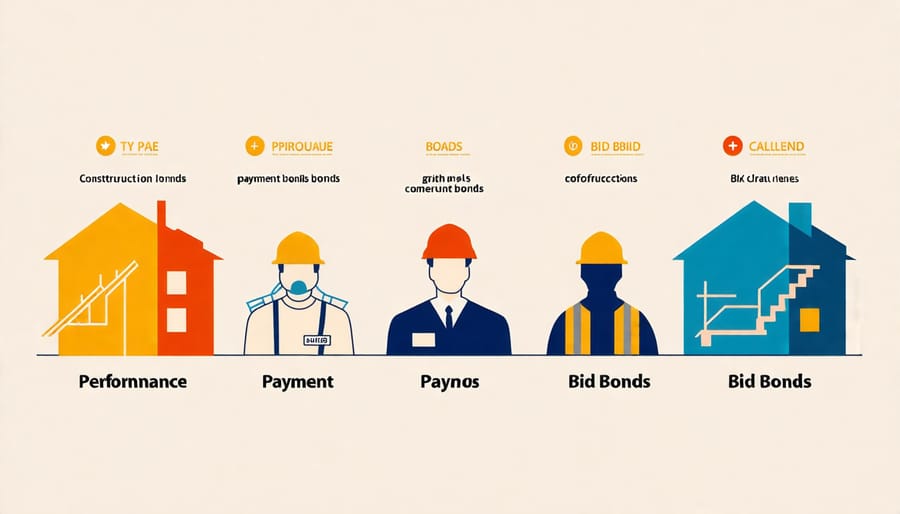Evaluate the necessity and scope of your construction project to determine the appropriate bond type—such as bid, performance, or payment bonds—each serving distinct protective roles throughout different phases of the project lifecycle. Conduct thorough due diligence on prospective bond issuers, assessing their financial strength and industry reputation to ensure they can support your project with adequate capacity and reliability. Integrate robust risk management strategies by securing comprehensive bonds, which can safeguard against various contingencies, thus protecting both the project and stakeholders from financial losses. Leverage insights from digital transformation initiatives to streamline bond financing processes, enhancing transparency, efficiency, and communication across all project phases.
Benefits of Bond Financing for Construction Projects
Increased Financial Security
Bond financing offers enhanced financial security for construction project stakeholders by providing a reliable source of funding and minimizing financial risks. Bonds, typically issued by governments or large corporations, are backed by the issuer’s creditworthiness, offering a level of assurance that other financing methods may not provide. This guarantees that the necessary capital is secured for the project’s duration, reducing the risk of funding shortages that can disrupt project timelines.
Additionally, bond financing imposes stringent oversight and financial discipline, requiring regular audits and detailed reporting. This transparency ensures all financial activities are closely monitored, fostering trust among stakeholders such as architects, engineers, and project managers. Furthermore, bonds often come with insurance coverage, protecting against unforeseen events that could potentially derail the project. By securing bonds, construction professionals can focus on executing their projects efficiently, knowing the financial aspects are well-managed and stable, thereby achieving project goals with greater confidence and credibility.
Risk Mitigation and Management
Bond financing provides a robust framework for mitigating risks in construction projects, safeguarding stakeholders’ interests by aligning financial motivations with project objectives. One of the foremost benefits of bond financing is its capacity to enforce accountability and performance guarantees among contractors. By requiring performance, payment, and bid bonds, project managers can ensure that contractors fulfill their contractual obligations, reducing the likelihood of delays and financial discrepancies. These bonds act as a safety net, encouraging adherence to project timelines and budgets. Furthermore, bond financing integrates seamlessly with construction safety essentials, providing an additional layer of commitment to safety standards on-site. Expert insights highlight that the inclusion of surety bonds can also enhance the project’s credibility, attracting investment and increasing confidence among stakeholders. Detailed case studies have demonstrated how bond financing can effectively transfer project risks from owners to bonded contractors, mitigating potential legal and financial exposures while ensuring project viability.
Cost Efficiency
Bond financing offers significant cost advantages for construction projects compared to traditional financing methods. By issuing bonds, project managers can secure large amounts of capital at competitive interest rates. Unlike bank loans, which often come with higher interest rates and more stringent conditions, bonds allow for more flexible repayment schedules and often lower costs over the bond’s life. Moreover, bonds can attract a wider pool of investors, spreading financial liability and enhancing risk management. These features make bond financing an attractive option for construction professionals seeking to optimize financial efficiency while maintaining the project’s fiscal stability.
Types of Bonds Used in Construction

Performance Bonds
Performance bonds are a critical component of bond financing in construction projects, offering a financial guarantee that ensures project completion according to contract terms. These bonds protect project owners and stakeholders from financial loss if contractors fail to fulfill their obligations. By transferring risk from the owner to the surety company, performance bonds provide an essential layer of security and confidence in project outcomes. They also serve as a powerful tool for maintaining accountability, incentivizing contractors to adhere to standards and timelines. For construction professionals, understanding the intricacies of performance bonds is crucial for mitigating risks and ensuring successful project delivery.
Payment Bonds
Payment bonds, a critical component of bond financing in construction projects, ensure that subcontractors and suppliers receive payment for their work, safeguarding against non-payment risks. These bonds are pivotal, as they shift the financial risk from smaller stakeholders who may not have the resources to pursue legal action, to the surety issuer. In practice, payment bonds thus facilitate smoother project execution by reassuring subcontractors of their compensation even if the main contractor defaults. This assurance encourages collaboration and continuity in project timelines, essential for successful completion. Understanding and utilizing payment bonds is crucial for construction professionals to mitigate financial exposure and maintain robust project dynamics.
Bid Bonds
Bid bonds play a crucial role in the tendering process for construction projects. These bonds serve as a financial assurance that the bidding contractor is serious about the project and will execute the contract at their stated bid price if awarded. They protect project owners by ensuring that bids are submitted in good faith, and they help prevent frivolous or inflated bids. Typically, the bid bond guarantees that a contractor will provide the necessary performance and payment bonds if their bid is accepted. This creates a foundational trust between the owner and contractor, facilitating smoother project initiation.
Bond Financing Process: A Step-by-Step Guide

Application and Underwriting
The application and underwriting process in bond financing for construction projects involves meticulous evaluation and strategic alignment with project goals. Initially, contractors or developers submit a comprehensive application detailing project specifications, financial assessments, and timelines. This application serves as the foundational document for the underwriting process, where financial institutions or bonding companies evaluate the project’s feasibility and the contractor’s credibility. Key considerations during this phase include assessing risk factors, ensuring compliance with regulatory standards, and verifying the contractor’s track record and financial health. The evaluation might involve expert interviews and could incorporate insights from procurement management strategies to ensure robust project execution.
Underwriters perform due diligence by analyzing past projects, financial statements, and management capabilities of the contracting party. They also assess mitigation strategies for potential risks identified during the review. This rigorous process helps determine the bond’s terms and conditions, aligning with specific project needs and ensuring that the venture is financially secure and strategically sound. By understanding the comprehensive application and underwriting framework, industry professionals can better prepare for successful bond financing outcomes.
Approval and Issuance
The approval and issuance of bonds for construction projects necessitate a meticulous process tailored to the financial and regulatory needs of the project. Initially, project proponents must develop a detailed proposal illustrating the project’s viability, anticipated costs, and revenue forecasts. This proposal, often supported by feasibility studies and expert interviews, is then presented to potential bond investors and relevant regulatory bodies. Approval hinges on a comprehensive evaluation of the project’s financial soundness and risk profile.
Once approved, the issuance phase begins, involving the preparation of offering documents such as the bond prospectus. These documents provide essential information about the bond terms, risk factors, and project details. Bonds are typically issued through underwriting processes facilitated by financial institutions that specialize in construction financing. These underwriters help determine the interest rate and market the bonds to potential investors.
Throughout this process, transparency and clear communication with stakeholders are paramount. By leveraging in-depth case studies and expert insights, project leaders can ensure a robust, compliant bond issuance strategy, ultimately securing necessary funding to propel construction projects forward.
Case Studies: Successful Bond-Financed Projects

The Hudson Yards project in New York City serves as a prominent example of successful bond-financed construction, showcasing how strategic financial planning can support large-scale urban development. Launched in 2012, Hudson Yards has emerged as the largest private real estate development in U.S. history, with its completion pegged at an estimated cost of $25 billion. By leveraging a combination of tax-exempt bonds and private investment, Hudson Yards has transformed a once underutilized section of Manhattan into a bustling hub of business, retail, and residential spaces.
The financing strategy for Hudson Yards involved a complex but effective interplay between various types of bond offerings. Special assessment bonds, funded through a dedicated revenue stream generated by a self-imposed levy, played a crucial role in covering the significant infrastructure costs while keeping the project financially feasible. Furthermore, taxable bonds were employed to bridge financing gaps, ensuring that the ambitious project could maintain its pace and timeline without financial hindrance.
Industry experts highlight the careful orchestration of public-private partnerships as pivotal to the project’s financial success. Interviewed stakeholders, including project managers and financiers, emphasize the importance of strategic communication between public entities, private investors, and construction teams. These partnerships facilitated not only the initial capital raise but also the requisite ongoing financial support, riding on a wave of investor confidence bolstered by the project’s scalability and potential returns.
The Hudson Yards project underscores the profound impact of well-structured bond financing for construction professionals aiming to undertake large-scale developments. It demonstrates the potential to innovate urban landscapes by aligning financial instruments with visionary urban planning, thus offering a blueprint for future mega-projects worldwide.
Expert Insights on Bond Financing
In the dynamic world of construction, bond financing remains a pivotal element in securing successful project outcomes. Experts in the field emphasize the importance of understanding its intricate tapestry—ranging from bid bonds to performance and payment bonds—each playing a critical role. According to Susan Chen, a seasoned financial consultant in the construction sector, “Bond financing not only assures project owners of contractor reliability but fosters a safety net for financial risks often encountered in large-scale developments.”
With the evolving landscape in construction technology trends, the integration of digital platforms in managing bond processes is gaining traction. Paul Rodriguez, a project manager with two decades of experience, notes, “Adopting digital solutions in bond management streamlines operations and provides real-time insights, crucial for decision-making.”
Looking ahead, these expert insights suggest a shift towards more adaptive and technology-driven bond financing models. This transition promises to not only enhance efficiency but also bolster financial robustness in construction projects, ensuring that project stakeholders are well-equipped to navigate the complexities of the industry.
Conclusion
In conclusion, bond financing plays a crucial role in the construction sector, offering security and fostering trust among stakeholders. As projects grow in complexity and scale, the demand for robust financial solutions will rise. By understanding bond types and their applications, industry professionals can enhance project execution and mitigate financial risks, paving the way for future innovation.

